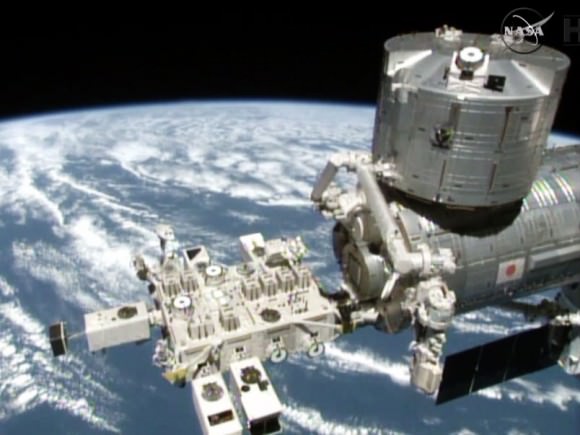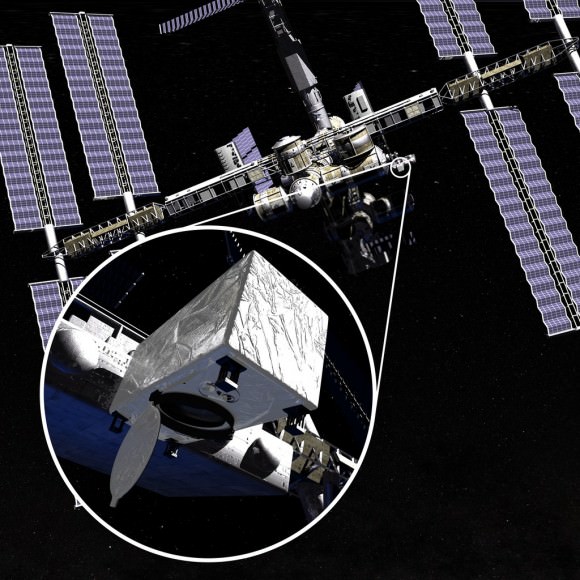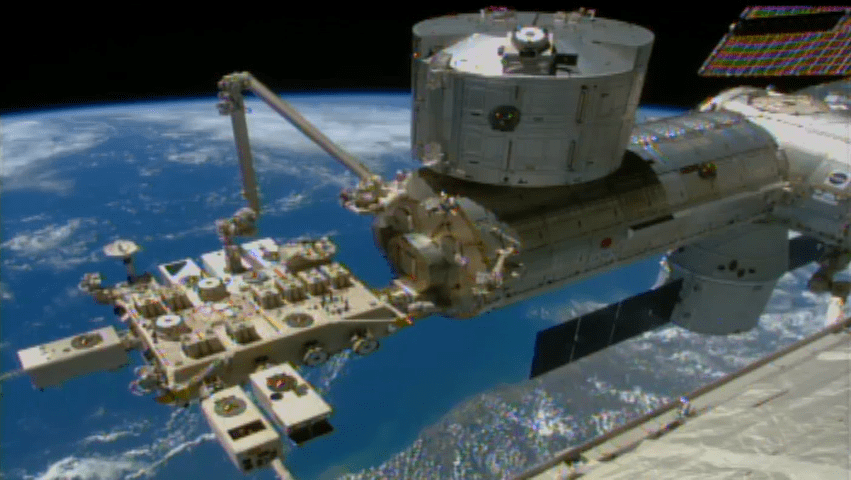The Japanese robotic arm installs the CATS experiment on an external platform on Japan’s Kibo lab module. The SpaceX Dragon commercial cargo craft is seen at the right center of the image. Credit: NASA TV
See way cool installation video below[/caption]
“Robotic controllers let the CATS out of the bag!” So says NASA spokesman Dan Huot in a cool new NASA timelapse video showing in detail how CATS crawled around the space stations gangly exterior and clawed its way into its new home – topped off with a breathtaking view of our home planet that will deliver science benefits to us down below.
The CATS experiment was installed on the exterior of the International Space Station (ISS) via a first ever type of robotic handoff, whereby one of the stations robotic arms handed the rectangular shaped instrument off to a second robotic arm. Sort of like relays runners passing the baton while racing around the track for the gold medal.
In this case it was all in the name of science. CATS is short for Cloud Aerosol Transport System.
Ground controllers at NASA’s Johnson Space Center in Houston plucked CATS out of the truck of the recently arrived SpaceX Dragon cargo delivery vehicle with the Special Purpose Dexterous Manipulator (Dextre). Then they passed it off to a Japanese team of controllers at JAXA, manipulating the second arm known as the Japanese Experiment Module Remote Manipulator System. The JAXA team then installed CATS onto an external platform on Japans Kibo laboratory.
CATS is a new Earth Science instrument dedicated to collecting continuous data about clouds, volcanic ash plumes and tiny airborne particles that can help improve our understanding of aerosol and cloud interactions and improve the accuracy of climate change models.
The remote-sensing laser instrument measures clouds and the location and distribution of pollution, dust, smoke, and other particulates and aerosols in the atmosphere that directly impacts the global climate.
Data from CATS will be used to derive properties of cloud/aerosol layers at three wavelengths: 355, 532, 1064 nm.
Check out this cool NASA ‘Space to Ground’ video showing CATS installation
Video caption: NASA’s Space to Ground on 1/23/15 covers CATS Out of The Bag. This is your weekly update on what’s happening aboard the International Space Station. Got a question or comment? Use #spacetoground to talk to us.
All the movements were conducted overnight by robotic flight controllers on the ground. They installed CATS to an external platform on Japan’s Kibo lab module.
CATS is helping to open a new era on the space station research dedicated to expanding its use as a science platform for making extremely valuable remote sensing observations for Earth Science.
The CATS instrument is the fourth successful NASA Earth science launch out of five scheduled during a 12-month period. And it is the second to be installed on the exterior of the ISS, following ISS-RapidScat that was brought by the SpaceX CRS-4 Dragon.
The fifth launch — the Soil Moisture Active Passive satellite — is scheduled for Jan. 29 from Vandenberg Air Force Base in California.
CATS was launched to the station as part of the payload aboard the SpaceX Dragon CRS-5 cargo vessel bolted atop the SpaceX Falcon 9 for the spectacular nighttime blastoff on Jan. 10 at 4:47 a.m. EST from Cape Canaveral Air Force Station in Florida.
CATS was loaded in the unpressurized rear trunk section of Dragon.

The new CATS experiment delivered by the SpaceX commercial cargo craft will be installed on a platform outside Japan’s Kibo Laboratory module. Credit: NASA
The Dragon CRS-5 spacecraft was loaded with over 5108 pounds (2317 kg) of scientific experiments, technology demonstrations, the CATS science payload, student research investigations, crew supplies, spare parts, food, water, clothing and assorted research gear for the six person crew serving aboard the ISS.
It successfully rendezvoused at the station on Jan. 12 after a two day orbital chase, delivering the critical cargo required to keep the station stocked and humming with science.

Stay tuned here for Ken’s continuing Earth and planetary science and human spaceflight news.


So, CATS is going to study Vulcanism and climate change. That’s exactly where we need to be studying climate change as volcanoes have been putting out green house gasses at several level of magnitudes higher than all of man kind has ever produced.
[Citation required]
This is not what I understand. It is difficult to measure the outputs of some volcanoes, and it was argued that something like Mount Erebus may have more effect than normal volcanoes because it (a) is an active stratovolcano, so outputs directly into the upper atmosphere (b) outputs more chlorine then most volcanoes, so is worse for depleting ozone, and (c) is well towards the poles so it has more effect.
U.S. Department of Energy’s Carbon Dioxide Information Analysis Center (CDIAC) website (http://cdiac.ornl.gov/) gives a figure of 200 million tonnes of CO2 for volcanic emissions. This figure may contain errors, but it is nowhere near the global fossil fuel CO2 emissions for 2003 which is 26.8 billion tonnes.
The sad thing is, you probably know this, but hoped the average reader would not check.
I stand by my words. When trying to predict when a Volcano is going to erupt, the very first gas looked at is CO2. But that’s not the only Green House gas that Volcanoes produce. And that’s not the only Climate Change mechanism that Volcanoes have. Even a relatively small Icelandic Volcano cause catastrophic Climate Change for Europe for several years. And that was only one Volcano.
which one was it?
… because volcanoes have a much longer history of producing those gases. We (mankind, mostly the industrial nations) have started just some centuries ago. But we cannot influence volcanoes as we can ourself, so why don’t we do it? Blaming the volcanoes doesn’t help at all.
If I dropped a penny out of 100 pennies, have I lost a dollar? Then if we spend 25 pennies trying to recover the one penny I dropped, does that make economic sense? This is where we are trying to blame climate change on man. This is why most scientists won’t blame man and need more scientific research to identify the exact nature of climate change. If you were really a scientist, you would know know that repeatable verifiable testing is the only way we can eliminate or assign percentages to all the variables that go into climate change.
Sort of like the chem trial myth. I proved that it would cost nearly 7/8ths of the total global GDP to have have chem trails. Still, people are convinced that a few wealthy people are financing it to happen.
Man made climate change is along those same lines. We can’t possibly produce enough Green House gasses to cause climate change. There are other factors at work and they need to be investigated. Some of the questions that need to be answered are: How fast can our planet recover from CO2 overload? How much CO2 is actually healthy for our planet? With nearly a dozen Volcanoes creating CO2 each year, why hasn’t our planet turned into Venus already?
One of the fastest ways we might actually be killing the planet is by clear cutting. Both in the Amazon and in the US long ago when settlers first traveled west. In Europe during WWI and WWII cleared millions of acres of forested land. The growth of the Sarah Desert which makes a lot of what man has done look quite insignificant. Even our Oceans are producing less oxygen now. All of these have an impact on our current situation. All of these need to be studied.
It may be our planet just has a huge natural cycle that has yet to be identified. But to blame man right now is making a very foolish statement. It’s like yelling out an answer without hearing the question.
Well-written, Ken! Just about perfect…..
Soichi Noguchi and Satoshi Furukawa have both flown missions on the ISS. Who is the next JAXA astronaut to go up and when will that be?